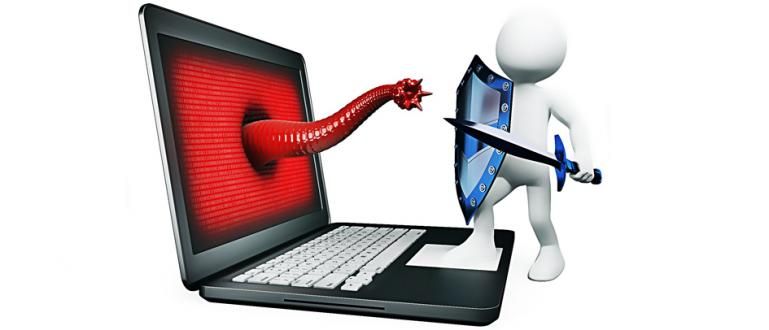Do you know the difference between malware and viruses? Know what Adware is? No need to be confused because ApkVenue will tell you several types of terrible digital viruses!
Just like diseases that attack humans, digital diseases that can attack our electronic devices also vary.
Maybe all this time we often refer to it as virus just. In fact, the virus is only one type of virus Malicious Software or commonly abbreviated as Malware.
Well, this time Jaka wants to review about what is malware and what is included in Malware!
What is Malware
As Jaka mentioned before, Malware is an abbreviation of Malicious Software. So, what does that mean?
Malicious software means software that can be used to interfere with computer performance, steal data, and other activities that can damage our devices.
Well, this malware turns out to be of many kinds, gang. Viruses that we often call are only a small part of the danger of Malware!
Then what is included in Malware?
Types of Malware
Reporting from various sources, ApkVenue has collected some of the most famous and most dangerous types of Malware.
1. Adware
 Photo source: Heimdal Security
Photo source: Heimdal Security The first is Adware or advertising-supported software. Judging from the name, it is clear that this type of malware is related to advertising.
The adware will automatically send advertisements which will surely annoy us. Usually, the free software that we download will contain Adware.
You have to be careful, gang if you want to find free software. Some Adware also comes with Spyware which Jaka will explain in the next few points.
Research first whether the software you are going to download really matches what you are looking for because there are many fake applications circulating, including Apex Legends!
2. Bot
Simply, bot is a program that is created to run a certain command automatically.
Did you know that bot is also a malware? But of course the bot in question here is a bot that is used to commit crimes.
An example of Bot abuse is DDos attack where it will consume website resources or RAM memory by sending bot accounts.
As a result, our website or device becomes slow. In order to avoid bot attacks, some sites use tests CAPTCHA to detect it.
3. Keyloggers
Types of malware Keyloggers will record all the information you enter using the physical keyboard.
How about a virtual keyboard? It's safe because Keyloggers don't have the capability to do that, but physical keyboards are very vulnerable to attack.
The purpose of Keyloggers is clearly to collect information such as personal data which will be sent to the sender of Keyloggers.
The information taken is usually a username and password to enter the website or information related to the credit card used.
Other Types of Malware. . .
4. Ransomware
 Photo source: lifewire.com
Photo source: lifewire.com Next there is Ransomware. This type of Malware is quite dangerous, because usually the Ransomware spreader will lock our access to our own devices.
There are many ways that can be done to hold our data hostage, such as locking the hard drive, displaying messages pop-up which cannot be removed, and so on.
In order to re-access, we are required to pay a certain nominal amount as a ransom.
5. Rootkits
No less scary than Ransomware is Rootkit. This type of malware is able to control your device remotely without being detected.
Once a Rootkit manages to get into your device, it can perform information theft, change system configuration, remove applications that can detect Rootkits, and so on.
Handling Rootkits is arguably very difficult because they are difficult to detect. One thing that can be done is to do a manual check to find out any unusual activity.
6. Spyware
 Photo source: Lynda
Photo source: Lynda Next there is Spyware, which from the name you might guess that this Malware can spy on your activities.
Spyware is able to harvest data such as account information, login data to a site, financial data, and much more.
Even some Spyware has been strengthened with additional capabilities such as changing security settings or interfering with network connections.
7. Trojan Horse
Trojan Horse or commonly referred to as just a Trojan is a type of Malware that disguises itself as a normal file or program to trick us.
When the Trojan has been on our device, it will provide remote access to the party that has spread the Trojan.
If this has happened, you definitely know what will happen: Data theft, installing more Malware, modifying files, monitoring user activity, and other spooky things.
8. Virus
 Photo source: Next Avenue
Photo source: Next Avenue Well, here are the most well-known types of Malware, to all types of attacks cyber also known as Virus.
Virus is one type of Malware that is able to replicate itself and spread to other computers quickly.
One way viruses spread themselves is by attaching themselves to certain software. When users install the software, they will be able to launch attacks.
In addition, viruses can also be spread through files or websites. Viruses can steal information, make computers super slow, and even steal money.
9. Worm
Last is Worm, one of the most well-known types of Malware. Worms spread through computer networks by exploiting operating system vulnerabilities.
The worm will damage the host network by consuming bandwidth and servers are redundant. Of course the resulting impact is just as scary as other malware.
Worms are similar to Viruses. The difference is, the worm can replicate itself without waiting for user activity such as a virus.
So, is Malware more dangerous than Viruses? Actually this question is not quite right because Virus is a type of Malware.
If the question becomes whether there is anything more dangerous than a virus, the answers are many. The points that Jaka has mentioned above are the proof.
Of course we hope that the device we use is not attacked by malware. For prevention, it's a good idea to install an antivirus and always updates your application!
Banner Source: SensorsTechForum.com
Also read articles about Malware or other interesting articles from Fanandi Ratriansyah









